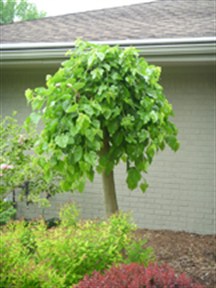This page Sponsored by:
You, too cane Sponsor! We need your help!:
Tired of looking at a scary-thick mass atop a weeping
mulberry?
Late winter's a great time to prune it!
1) Take a deep breath. You are going to remove a lot of wood. It
is no trouble for the plant, which can grow all you see here in one
year, and more if it's in sun!
2) Step under the tree. Most of the dead wood is there,
and the framework the tree has or can have is apparent there.

3) Begin cutting out dead wood. It's brittle, gray, and has no
leaf buds. Don't be concerned about where you make the cuts --
you'll cut back even further later. Just get all that dead stuff
out of the way. Be prepared to be rained upon by flakes and dust
and other plant dandruff.
4) As you clear out what's dead, notice the tree's main
branches. Elect 3 or 4 to be the main framework. Don't ask anyone
else to decide -- this is a subjective, artistic choice as much as
anything. However, there is one thing we consider that might help
you decide: To be eligible to be a main limb, it should radiate
from the trunk into its own section of sky, not compete with a
sister limb to fill the same air space with leaves.
More help in deciding: These diagrams in Prune to Keep a Tree
Small



Arrows point to some of the dead wood. Lighter in color than
the yellow-brown live wood, and without buds.

5) Now look at the side branches. We define "side branch" as one
that arises from one of the trunks/branches we've designated as
"main." Cut side branches back to allow a year's growth. Thin the
side branches to leave the main branch with only its best and
strongest, spaced out along its length.
6) When you get done, the tree can look like the one at the top
of the page, or like this one below. Either way, the tree will be
full of foliage and ready to be clipped again in June or July to
take out stragglers.
If it weeps, this works
7) This method of working from underneath, beginning with dead
wood, designating main limbs and then thinning will work for any
weeping tree, from mulberry through cherry and pussy willow to
Japanese maple. Mulberries can be cut more severely than the others
without qualm, since flower buds are not an issue and the tree
grows very quickly. The slower the tree's growth rate, the less
severe the annual cut.


There is more we long to add here. You can help finish this!

To see more of the Sponsor-recommended
pages...
All of our
work will be posted in time, but...
There is a great deal to post -- as of this writing we have
about 900 pages posted, of about 3,000 in queue. That includes more
about mulberries and many other pruning projects
Because we have so much but there are only the two of u to get
it done, the information we have already published and which is
still available in books, magazines and on
CDs, is last in line for posting unless a Sponsor request calls
it forward.
 There is more about pruning weeping
mulberries, including before-after photos and diagrams, in What's
Coming Up #19 and What's
Coming Up #35 . These issues and 100 others are available
on our CD, Asking About Asters.
There is more about pruning weeping
mulberries, including before-after photos and diagrams, in What's
Coming Up #19 and What's
Coming Up #35 . These issues and 100 others are available
on our CD, Asking About Asters.
You can purchase our CD Asking About
Asters, or
You can Sponsor a page on the
topic of your choice and request "pruning weeping mulberries"
as the topic you want to sponsor.
